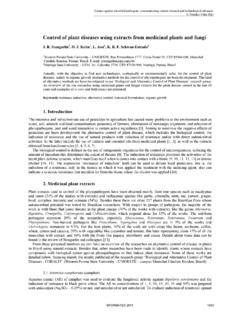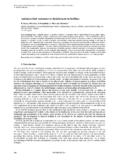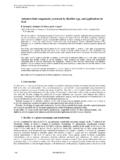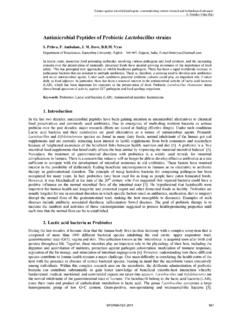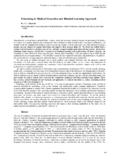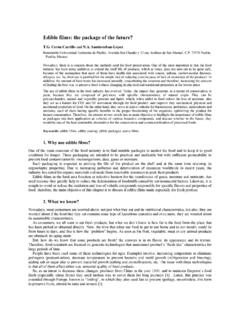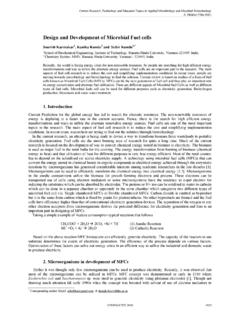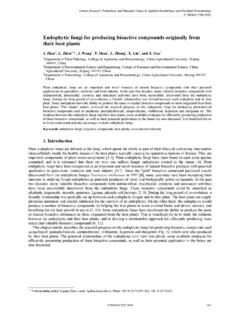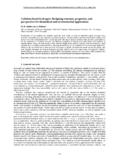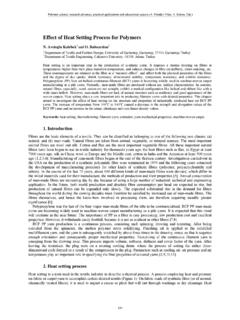Transcription of New advances in polymeric membranes for CO separation
1 Polymer science: research advances , practical applications and educational aspects (A. M ndez-Vilas; A. Solano, Eds.). _____. New advances in polymeric membranes for CO2 separation Abtin Ebadi Amooghin1,*, Hamidreza Sanaeepur1, Mona Zamani Pedram2, Mohammadreza Omidkhah3 and Ali Kargari4. 1. Department of Chemical Engineering, Faculty of Engineering, Arak University, Arak 38156-8-8349, Iran 2. Department of Energy System Engineering, Faculty of Mechanical Engineering, K. N. Toosi University of Technology, No. 15, Pardis St., Molasadra Ave., Vanak Sq., Tehran 3. Faculty of Chemical Engineering, Tarbiat Modares University, Box 14115-143, Tehran, Iran 4.
2 Department of Chemical Engineering, Amirkabir University of Technology, Box 15875-4413, Tehran, Iran * Corresponding author: email: Energy has been proposed as a feed of the long-term development. Fossil fuel burning serves the main part of energy needs. The projections of world energy consumption by all the energy sources up to the mid-21stcentury introduce natural gas stays on ahead of the others. It involves with the simultaneous challenges of CO2 separation from natural/bio gas (acid gas removal) as well as subsequent capture of CO2 emitted from power plants (in order to mitigating the global warming accompanied by CO2 emission).
3 membrane gas separation has crucial advantages among all other CO2 separation technologies such as absorption, adsorption, and cryogenic distillation. One of the main purposes of research in membrane gas separation is fabrication of membranes with superior permeability and selectivity. Although polymeric membranes possess many advantages such as the ability for easy fabrication of large membrane areas at low cost, they suffer from problems associated with the trade-off relationship between permeability and selectivity. Therefore, they traditionally undergo an upper bound limitation. Although there are many opportunities for polymeric -based membrane for gas separation applications, but most of the existing membrane materials cannot economically utilize in these opportunities.
4 Therefore, even today, many progresses are made in alternative emerging materials in order to develop the CO2 separation performances. There are various methods have been examined to improve current levels of membrane performance such asgrafting, blending, crosslinking, ion-exchange treatment, mixing with suitable dense/molecular sieve fillers and etc. This chapter is especially devoted to explain challenging issues affect the CO2 separation properties of conventional polymeric membranes . Moreover, advanced classes of highly CO2 separation performance polymeric membranes are summarized. Keywords: advanced polymers; membranes ; CO2 capture; natural gas; greenhouse gases.
5 1. Introduction membrane Technology membrane is generally defined as a selective barrier between two phases. In other words, membrane is a thin solid and/or fluid film which is mainly characterized by permselectivity properties of penetrants. It must be noted that the pentrant flux is affected by the physical structure of the membrane , while the transport driving force through the membrane is the chemical potential gradient. Hence the selectivity is considered as a discrepancy in flux between penetrants [1]. The membrane gas separation industry has grown dramatically over the past four decades and this growth has been owed to the fast development of more efficient membranes with higher permselctivities.
6 As it is known, the first membrane gas separation industrial systems were experienced in 1979 1980 for separation of H2 from the N2, argon, and CH4. The economic benefits of the hydrogen recovery led to very rapid installation of several systems around the world [2]. Afterwards, membrane gas separation was used in other applications such as separation of CO2 from natural gas, N2 from air and H2 from different refinery and petrochemical process streams [3-5]. This is due to noteworthy advantages of membranes such as low cost, high efficiency, simple operation, modularity and easy to scale up and the outstanding one; continuous steady-state conditions which gas separation devices can operate under them.
7 Up to now, despite the fact that thousands of new materials used in membrane gas separation technology, but unfortunately only a limited number of them are employed in the industry [2]. membrane gas separation are used in many applications such as the separation of N2 or O2 from air, separation of H2. from N2 and CH4, H2 recovery from product streams of ammonia plants and also in oil refinery processes, separation of CH4 from biogas, air enrichment by O2 for medical or metallurgical applications, water vapor removal from natural gas and other mixtures, CO2 and H2S removal from natural gas, volatile organic liquids (VOLs) removal from exhaust streams [1].
8 membrane materials for gas separation must possess the intrinsic-tailoring properties such as: 1) stability for use in long-term purposes 2) acceptable permselectivity 3) well membrane structure and thickness 4) suitable design of modular system [3]. 354. Polymer science: research advances , practical applications and educational aspects (A. M ndez-Vilas; A. Solano, Eds.). _____. membrane CO2 separation Nowadays, the amount of greenhouse gases (GHGs) in the atmosphere has increased significantly [6]. The severe sideffects of carbon dioxide accumulation in the environment as a main constituent of greenhouse gases, causes too much attention to the variety of separation methods of CO2 from the flue gases.
9 As previously mentioned, polymeric membrane gas separation is a promising technology, if the prepared membranes have good intrinsic properties such as high permeability, moderate selectivity, longterm reliable working at specific operating conditions in post-combustion (flue gas mixture at 323 K and atmospheric pressure with at least 10-15% CO2 content) [7-17]. In general, polymeric membranes with pemeance>1000 GPU and selectivity>30 are the good candidates for CO2 separation from the flue gases [18, 19]. On the other hand, the separation of CO2 and CH4 is also a well-known industrial process. To demonstrate the importance of this issue, it is sufficient to point out that the need to considerable treatment of approximately 20% of the US annually natural gas, which is about 20 trillion standard cubic feet, is clearly showed the volume of financial and operational separation process [20].
10 More importantly, at higher concentrations of CO2 (more than 2%) in pipeline, many disadvantages are appeared such as pipeline corrosion as well as decreasing the heat value of natural gas [20-22]. Comparing with conventional methods, membrane gas separation reveals certain advantages including high efficiency, low cost and environmental impact [23-26]. However, the main problems of current polymeric membranes are the restriction of permselectivity (they only can process low volumes of gas less than 30 million of standard cubic feet per day), and unsatisfactory thermal-chemical stability and surrender to plasticization [20, 23].
